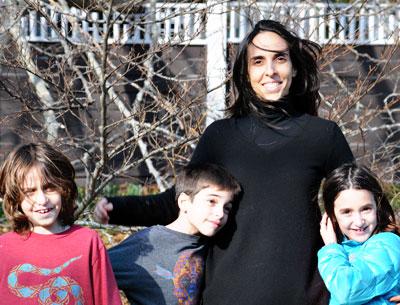Feeling Arty in The Museum

A young girl glides through a museum that has some of the greatest works of art on display. In verse she finds herself reacting to the surroundings. Vincent van Gogh’s “Starry Night” makes her “twirly-whirly, twinkly, sparkly, super swirly.” Edvard Munch’s “Scream” makes her gasp, and a Degas dancer has her up on her tippy toes.
The illustrations of the paintings and surroundings in “The Museum” are by Peter H. Reynolds, a popular and critically acclaimed illustrator from Boston. The words are homegrown, however, penned by Susan Verde, an East Hampton educator, writer, and children’s yoga instructor.
Published by Abrams earlier this month, this is her first children’s book. The book itself is also of South Fork vintage, having its genesis at the Southampton Writers Conference under the guidance of Emma Walton Hamilton.
In a way, it was a quid pro quo, Ms. Verde recalled recently over coffee. “There is some history there. I taught her son at the Hampton Day School through nursery school and kindergarten.” They then reconnected as parents when her daughter and Ms. Verde’s son entered the same class.
“I had all these ideas brewing and had been writing all of my life, but I really started writing children’s books over the last couple of years.” She took some of her ideas to Ms. Hamilton, who suggested that Ms. Verde take her workshop at the conference, which is held every summer at the Stony Brook Southampton campus.
A year later, after refining a number of ideas from the previous workshop and finding new ones through her own children and other sources, she took the children’s workshop again, this time with Mr. Reynolds. “One of the wonderful perks of being in the workshop was to show him my work. He came across ‘The Museum,’ gave me a few suggestions, and in the same breath said, ‘I want to illustrate this.’ ”
Ms. Verde was floored. “Are you talking to me?” she recalled saying to herself. Still, she took the opportunity and ran with it, going home to work it over and refine it. “We met a few more times and it became this amazing story.”
It was a story inspired by Ms. Verde’s three children and an afternoon they spent at Guild Hall — “particularly one of my sons. We were looking at all of the paintings and he was starving. We had seen a painting of food, and he was complaining and writhing on the ground and I thought, ‘Oh my God, how am I going to distract him?’ ” She found some paper and started writing a poem “about how all the various pieces of art made us feel. And it worked.”
It began as a chronicle of that day, but as she reworked it, she decided to make it more universal, including all of “the art that had inspired and influenced me and made me feel something.” Ms. Verde was raised in Manhattan and had seen many of the pictures she chose in New York City as she was growing up.
The book took about two years to be completed. Her collaboration with Mr. Reynolds was unusual. “Typically, the writer doesn’t get to meet the illustrator,” who is usually assigned by the publisher, “but we got to create a dummy together, and Mr. Reynolds suggested giving it to his agent,” who took it to Abrams.
The book was launched in Massachusetts at a bookstore in Dedham that Mr. Reynolds owns. There will be other events here in the summer to mark its publication.
The response has been positive, including from Ms. Verde’s favorite critic, a second grader who gave it “two thumbs up and all toes up” after hearing it read in a class in Massachusetts. She is currently working on a few other ideas for more children’s books, all in the formative stages.
Ms. Verde received her degree in education at the old Southampton College and taught preschool and kindergarten at the Hampton Day School for several years. She then had her own children: Joshua and Gabriel, twin boys who are 9, and Sophia, her 7-year-old daughter. She now teaches yoga to children at the Ross School’s lower campus.
Children’s yoga “is very different from adult yoga,” she said. “I take my adult classes in the morning and feel grounded and peaceful, but that’s not yoga for children.” She said there are meditation and grounding in children’s yoga, but of a different sort. “There’s a lot of moving and talking. It’s certainly not quiet.”
Her goal in this practice is to teach her students body awareness — “where they are and how they feel and how they can manage those feelings.” The meditation portion is “not chanting and Sanskrit, but a lot of good self-talk.” She said one of the most valuable things the children learn is how to connect with their breath. “Anywhere you are, whenever things are too busy or too crazy, you can find your breath. It’s always there.”
A mother of one of her students told her recently that she was in the supermarket with her daughter and she stopped what she was doing and started to breathe deeply. Ms. Verde said the woman asked her daughter what she was doing and her daughter replied, “ ‘Susan told me I could just breathe when I was feeling a little crazy, and that’s what I’m doing.’ I love hearing that.”
Although there has been some concern in other states about a possible religious component of yoga, Ms. Verde said, “It’s really about managing who you are and treating yourself well . . . connecting your body with your mind. The biggest part of it is getting them to relax. Even 15 seconds is a long time to be lying there, not touching their neighbor, not talking. But they manage it and over time it gets better.”
